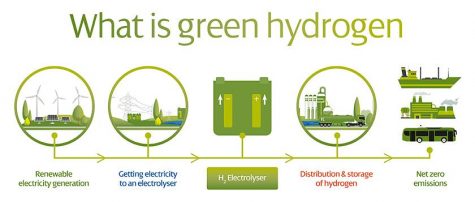How is green hydrogen made?
Green hydrogen represents a clean energy source with the potential to play a significant role in reducing global carbon emissions. As sustainability becomes a practice at the forefront of people’s minds, the need to push manufacturing and engineering in a ‘greener’ direction becomes more important.
To better understand green hydrogen and its benefits, let’s investigate how it’s produced and its potential to replace harmful energy sources.
The Basics of Green Hydrogen

Green hydrogen is produced using renewable energy sources such as wind, solar, or hydroelectric power. The key to its ‘green’ properties lies in the way it is made. To produce green hydrogen, a process known as electrolysis is used.
Electrolysis involves passing an electric current through water to separate it into its two components: hydrogen and oxygen. When the electricity used in this process comes from renewable sources such as wind, solar or hydroelectric power, the hydrogen produced is considered green. This is because the overall process does not emit any greenhouse gases.
While green hydrogen currently only accounts for less than 0.04% of the amount of hydrogen produced, it is a useful resource for sectors such as the construction industry, shipping, or aviation where decarbonisation (the process of reducing carbon dioxide and other harmful greenhouse gases from the atmosphere) is particularly difficult.
The Role of Renewable Energy
The electricity required for electrolysis can be generated from various renewable sources:
- Solar Power: solar panels convert sunlight directly into electricity.
- Wind Power: Wind turbines generate electricity by harnessing the kinetic energy of the wind.
- Hydroelectric Power: Water flow is used to generate electricity through turbines.
Renewable energy sources are the height of sustainable developments and offer alternative methods of producing energy that doesn’t deplete finite resources from the natural environment such as fossil fuels.
As technology advances and we seek ways to combat climate change, renewable energy continues to grow in importance and promises a future where energy sources benefit us without draining the environment.
The Future of Green Hydrogen
Although it is the more sustainable option, green hydrogen incurs much higher costs compared to hydrogen sourced from fossil fuels. However, with advancements in technology and increased investment, green hydrogen has the potential to become more cost-effective and widely used.
Green hydrogen offers a glimpse into a future where our energy needs are met without harming the planet. As we continue to innovate and invest in renewable technologies, green hydrogen is a promising way of achieving net-zero emissions and combating climate change. Understand this topic in more depth from informative sources like acciona and the Department of Energy.

igus® dedication to sustainable alternatives
As a motion plastics company, the term ‘plastics’ often raises red flags in terms of environmental impact. As a manufacturer of high-performance polymers, we know that they can be used to protect the environment and its resources and have made this a focal point.
We have more blogs available on various sustainability topics for you to read and learn about environmental areas of manufacturing and engineering.
Our products are designed to target customer pain points and they get used in a variety of applications, so their sustainable properties benefit various industries. igus® products provide a longer service life, are self-lubricating, eliminating the need for downtime to lubricate. Customer applications therefore function using lasting, cost-effective parts rather than short-term solutions that are damaging to productivity and the environment.
We have also implemented many initiatives from litter picking to tree planting projects to ensure that our surrounding areas are looked after and we encourage all of our employees to take part. Keeping our location clean and helping it to thrive benefits wildlife, our employees and the surrounding businesses.
Find out more about our sustainable initiatives here.



